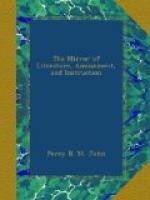“While the man beating the long drum, at the opposite end, another the cymbals, and the third blowing a trumpet, with the windows all crowded with spectators, complete the composition, with the exception of the melancholy victim behind the High Sheriff.
“I recommend the contemplation of this miserable creature, once a gentleman, to all advocates of imprisonment for debt. First rendered reckless by imprisonment—then hopeless—then sottish—and, last of all, from utter despair of freedom, insane! Round his withered temples is a blue ribbon, with ‘Dulce est pro Patria mori,’ (it is sweet to die for one’s country); for he is baring his breast to rush on the bayonets of the guards, a willing sacrifice, as he believes, poor fellow, for a great public principle. In his pocket he has three pamphlets, ’On Water Drinking, or The Blessings of Imprisonment for Debt,’—and Adam Smith’s ’Moral Essays.’—Ruffles hang from his wrists, the relics of former days, rags cover his feeble legs, one foot is naked, and his appearance is that of a decaying being, mind and body.”
Such is Mr. Haydon’s “Explanation” of his own Picture; and it only remains for us to give the reader some idea of its most prominent beauties. As a whole, it is very superior to the “Election,” highly as we were disposed to rate the merits of that performance. The style is masterly throughout, and every shade of the colouring has all the depth and richness which characterize works of real genius. There is a spirit in every touch which differs as much from the softened and soulless compositions of certain modern artists, as does the florid architecture of the ancients from the starved proportions of these days, or the rich and graceful style of the Essayists from the fabrications of little, self-conceited biographers. In short, the whole scene is dashed off in the first style of art; the subject and humour are all over English—true to nature, and so forcible as to seize on the attention of the most listless beholder.
We must notice a few of the details. The three guards are foremost in the picture, and in merit; the struggle in their countenances between discipline and a sense of the ludicrous scene before them is admirably represented; as well as the little urchin with his tin sword. The centre figure of the High Sheriff, with his tattered and faded finery of office, is equally clever; but the skill with which the artist has contrived to express his forced mirth, and mopstick bravado, is still more forcible. The troubled countenance of the Lord Mayor is an excellent portrait of the indignation of little authority when perturbed by men of greater place. The faces of the turnkey and the sergeant are likewise admirable; and that of the soldier looking towards the latter for orders, is like an excellent piece of byplay in the farce. The drunken patriot, behind the High Sheriff, is well entitled to the attention which the artist, in his explanation, suggests; but the spectator must not dwell




